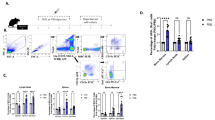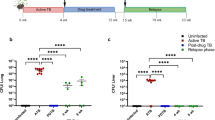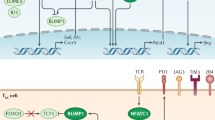Abstract
Mice infected with an aerosol of influenza type A virus, or immunized with purified UV-inactivated whole virus or with viral subunits, develop a transient delayed-type hypersensitivity (DTH) which peaks 5–7 days after immunization1. The intensity of DTH is greatly enhanced and sustained when mice are pretreated with cyclophosphamide1. The reaction is maximal 24 h after elicitation, has classical tuberculin-type histology and is transferable by immune H–2I region restricted Lyt-1+2− T cells (Td) but not by immune serum1,2. These Td cells not only fail to protect mice against influenza virus infection3, but increase the mortality rate due to influenzal pneumonia following challenge with homologous lethal virus3,4. On the other hand, antigen-specific suppressor T (Ts) cells which inhibit DTH are readily generated during influenza virus infection, and are detectable for at least 40 days thereafter5. The ease with which they are induced and maintained during the infection may be of evolutionary advantage6. In support of this, we now report that these Ts cells can reverse the pathogenic effect of Td cells thereby demonstrating a beneficial influence of Ts, cells in a viral disease.
This is a preview of subscription content, access via your institution
Access options
Subscribe to this journal
Receive 51 print issues and online access
$199.00 per year
only $3.90 per issue
Buy this article
- Purchase on Springer Link
- Instant access to full article PDF
Prices may be subject to local taxes which are calculated during checkout
Similar content being viewed by others
References
Liew, F. Y., Russell, S. M. & Brand, C. M. Eur. J. Immun. 9, 783 (1979).
Leung, K. N., Ada, G. L. & McKenzie, I. F. C. J. exp. Med. 151, 815 (1980).
Leung, K. N. & Ada, G. L. Scand. J. Immun. 12, 393 (1980).
Cate, T. R. & Mold, N. G. Inf. Innum. 11, 908 (1975).
Liew, F. Y. & Russell, S. M. J. exp. Med. 151, 799 (1980).
Liew, F. Y. Immun. Today 3, 18 (1982).
Parish, C. R., Kirov, S. M., Bowern, N. A. & Blanden, R. V. Eur. J. Immun. 4, 808 (1974).
Wagner, R. R. Yale J. biol. Med. 28, 598 (1956).
Ramshaw, I. A., McKenzie, I. F. C., Bretcher, P. A. & Parish, C. R. Cell Immun. 31, 364 (1977).
Liew, F. Y., Sia, D. Y., Parish, C. R. & McKenzie, I. F. C. Eur. J. Immun. 10, 305 (1980).
Kina, T., Nishikawa, S. & Katsura, Y. Immunology 47, 525 (1982).
Liew, F. Y., Hale, C. & Howard, J. G. J. Immun. 128, 1917 (1982).
Germain, R. N. & Benecerraf, B. Scand. J. Immun. 13, 1 (1981).
Okuda, K., Minami, M., Furusawa, S. & Dorf, M. E. J. exp. Med. 154, 1838 (1981).
Green, W. F. & Colley, D. G. Proc. natn. Acad. Sci. U.S.A. 78, 1152 (1981).
Howard, J. G., Hale, C. & Liew, F. Y. J. exp. Med. 153, 557 (1981).
Author information
Authors and Affiliations
Rights and permissions
About this article
Cite this article
Liew, F., Russell, S. Inhibition of pathogenic effect of effector T cells by specific suppressor T cells during influenza virus infection in mice. Nature 304, 541–543 (1983). https://doi.org/10.1038/304541a0
Received:
Accepted:
Issue Date:
DOI: https://doi.org/10.1038/304541a0
This article is cited by
-
Inhibition of IL‐2 production by nitric oxide: A novel self‐regulatory mechanism for Th1 cell proliferation
Immunology & Cell Biology (1997)
-
Respiratory syncytial virus
Archives of Virology (1985)
Comments
By submitting a comment you agree to abide by our Terms and Community Guidelines. If you find something abusive or that does not comply with our terms or guidelines please flag it as inappropriate.



